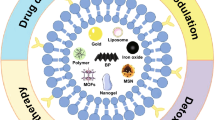Summary
Experiments were conducted in which normal human red blood cells (RBC) were subjected to osmotic hemolysis (hypotonic NaCl and urea) in the presence of different concentrations (0–20 mM) of three surface active substances (Pluronic® F 38, F 68, F 108). All three substances exhibited an antihemolytic effect which increased with increasing concentrations and was most pronounced in the case of F 108. Measurements of intracellular osmolarity, hemoglobin concentration, RBC count, and hematocrit showed that in the presence of 2 mM/F 108 the cells exhibit an increased critical hemolytic volume. Osmotic equilibrium with the suspending medium is achieved by water influx through the membrane which is not inhibited by Pluronic. It is conceivable that in the presence of Pluronic the RBC membrane becomes more resistant against tangential stresses.
Zusammenfassung
Normale menschliche rote Blutzell (RBC)-Suspensionen wurden einer osmotischen Hämolyse in hypotonischer Kochsalz- und Harnstofflösung unterworfen bei Gegenwart von Pluronicpolyolen F 38, F 68 und F 108. Diese drei oberflächenaktiven (Oberflächenspannung herabsetzenden) Substanzen kamen in verschiedenen Konzentrationen (0–20 mM) zur Anwendung und zeigten einen antihämolytischen Effekt. Dieser nahm zu mit steigender Konzentration. Am deutlichsten war die Wirkung bei F 108. Die Messung von intrazellularer Osmolarität, Hämoglobinkonzentration, RBC-Zählung und Hämatokrit zeigte, daß in Gegenwart von 2 mM F 108 die Zellen ein vergrößertes kritisches hämolytisches Volumen besaßen. Osmotisches Gleichgewicht im Suspensionsmedium wurde erreicht durch Wassereintritt durch die Membran. Die Anwensenheit oberflächenaktiver Substanzen störte diesen Vorgang nicht. Es ist denkbar, daß bei Gegenwart solcher Stoffe die Zellenmembran gegen Tangentialspannungen widerstandsfähiger wird.
Similar content being viewed by others
References
BASF Wyandotte Corporation: Pluronic® polyols toxicity and irritation data, 3rd edition 1971.
Castle, W. B. and G. A. Daland: Susceptibility of erythrocytes to hypotonic hemolysis as a function of discoidal form. Amer. J. Physiol.120, 371–383 (1937).
Ehrly, A. M.: Untersuchungen über Wirkung und Wirkungsmechanismus verschiedener oberflächenaktiver Substanzen und Pharmaka auf Erythrocytenaggregate, Blutkörperchensenkungsgeschwindigkeit, Viskosität und Hämatokrit menschlichen Blutes. Ärztl. Forsch.21, 323–334 (1967).
Hoffman, J. F., M. Eden, J. S. Barr and R. H. S. Bedell: The hemolytic volume of human erythrocytes. J. cell. comp. Physiol.51, 405–414 (1958).
Ponder, E.: Hemolysis and related phenomena. Grune & Stratton, New York 1948.
Ponder, E.: The measurement of red cell colume: VI. The different “fragility” of the red cells of various mammals. J. Physiol. (Lond.)83, 352–358 (1935).
Ponder, E. and E. J. Robinson: The measurement of red cell volume: V. The behaviour of cells from oxalated and from defibrinated blood in hypotonic plasma and saline. J. Physiol. (Lond.)83, 34–48 (1934).
Roze, M. C.: Comportement osmotique des hématies dans des solutions d'un détergent non ionique: le “Pluronic F 68” C. R. Acad. Sc. Paris263, 1615–1618 (1966).
Author information
Authors and Affiliations
Rights and permissions
About this article
Cite this article
Gaehtgens, P., Benner, KU. Osmotic behaviour of human red blood cells effect of non-ionic detergents. Blut 29, 123–133 (1974). https://doi.org/10.1007/BF01633836
Received:
Issue Date:
DOI: https://doi.org/10.1007/BF01633836




